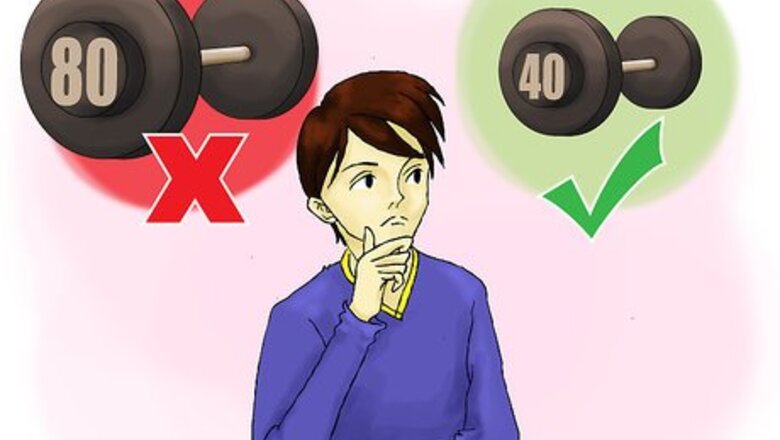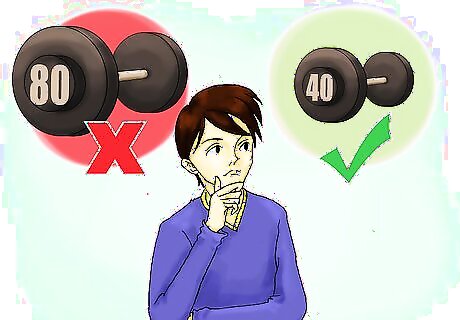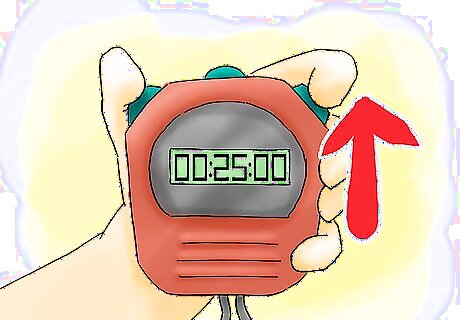
views
Setting Realistic Goals

Start small. Commit to what you can do right now. If you know you have trouble running more than a mile, start with what you can do. That is, instead of saying, "I'm going to start running 4 miles tomorrow," start with "I will run a mile tomorrow. Each day, I'll try to run a little more than I did the day before."

Define your goals. If your goals are vague, you're less likely to get things done. However, if you're more specific by choosing something measurable, you're more likely to be able to commit. The SMART method is helpful here, which stands for specific, measurable, achievable, results-focused, and time-bound. This step covers "specific." For instance, your goal could be "Start running 20 minutes a day to improve my health and work towards running a 5K in one year's time." Be sure to break your goals into small steps. If you commit to running a half marathon tomorrow when you've never run a day in your life, you're going to fail. You have to start small enough that you can actually accomplish your goals, such as saying you will start by running in 5 minute stretches.

Make sure your goal is measurable and achievable. The "M" and "A" part of SMART stands for "measurable" and "achievable." Measurable means you choose goals you can actually observe yourself meeting. In the instance above, you have made it your goal to run a 5K by a certain date, which is measurable. It's also small enough to be achievable. If it's not, you won't work towards it. For instance, if you had said you wanted to run a marathon by next week, that would not be achievable.

Ensure your goal is results-focused. That is, the main thrust of the goal should be what you achieve in the end, not how you get there. In this case, your main goal is to run the 5K, not to run every day.

Give yourself a time limit, the "T" part of SMART. If you make a goal without a time limit, you're not as likely to follow through because it's a little vague. You must set a time limit for your goal to be measurable. In this case, you gave yourself a year to reach your goal of running a 5K.

Act on your goals. Once you've outlined your goals, it's time to jump in. Start following through with the small goals you've set for yourself. Try to work on them each day if you can.

Praise yourself when you follow through. You've accomplished something, now give yourself some praise for it. It's good to tell yourself you did a good job, even if you only met part of your goal.

Don't be afraid to up the ante. Over time, you are going to meet your goals. As you do, you can increase the goal or set new ones. For instance, if you said you were going to run 20 minutes a day, and you've been doing that for awhile, maybe now you can run 25 minutes a day.

Reward yourself. As you meet your goals, it's a good idea to have a reward system in place. It can be anything you enjoy, from books to a nice coffee. For instance, say you wanted to run 20 minutes a day for a week. Once you meet that goal, you can have your reward.
Psyching Yourself Up

Challenge yourself about inaction. The action you need to take is scary because it's something new and out of your comfort zone. Therefore, it feels better and easier to stay where you are. However, you need to think about what will happen if you don't take action. That is, if you keep doing what you've always done, what are the negative effects going to be? For instance, maybe you'll be stuck in the same patterns that you are obviously unhappy with. Take out a piece of paper. Write down the negative effects of not taking action.

Focus on the long-term. Currently, you're focusing on what would bring you pleasure in this moment, and that's not taking action, as it makes you uncomfortable. Instead, look at the long-term benefits. What would happen if you took action? On the same sheet of paper, label a section "benefits." Write down how you would benefit from taking action. For instance, you could write something such as "Would start a new job."

Explore. If you find yourself just not being able to make any decisions about how you want to move forward, you may need to just get out and try some new things. Go take a class. Read some books. Try some new hobbies. Getting out of your comfort zone and trying new things can help you jump start your life. For short-term motivation, look at the day-to-day habits of people you look up to. Then, use that information for tips on how to be productive and keep moving toward your goals. Think about the things you liked when you were younger. That might give you insight into something you feel passionate about—you're more likely to feel motivated if you're excited about what you're doing. You can also try focusing on how you want to give back to the world when you're trying to make long-term plans for your life.

Learn to tolerate uncertainty. If you can't tolerate any uncertainty in your life, you'll spend a lot of time hesitating and trying to rid yourself of the inevitable uncertainty you face. It's better to learn to tolerate that uncertainty, so you can spend your energy on moving forward with your goals. Start by noting what behaviors you practice to reduce uncertainty. For instance, maybe you double-check emails to friends to make sure they're perfect or maybe you only go to restaurants you know you like because you don't want to be caught trying something new that you may not like. Once you figure out the behaviors, make a list of which ones would cause you the most anxiety to stop doing. Starting on the lower anxiety end, work on stopping or changing some of the behaviors on your list. Try letting someone else plan an evening for you or sending a text to your friend that you didn't double-check for errors. Take note of the times you are able to accomplish stopping these behaviors, and how it made you feel. You may find that it makes you excited or that you still feel anxious. Nonetheless, you'll likely find that the result is still fine, even if everything didn't go as smoothly as you would have liked. Keep working on your behaviors to ensure you keep tolerating uncertainty in your life.
Stopping Procrastination

Start with the easiest step first. When you're looking at a task you don't want to do, it can seem overwhelming. However, try picking the part of the task you hate the least or the part that is the easiest for you. By just getting started, you have the biggest hurdle out of the way, plus you'll feel accomplished.

Don't define yourself as a procrastinator. If you are always calling yourself a procrastinator, then you'll be one. In other words, that if you always identify that way, you are setting yourself up to act that way. Instead, say things such as "I like to get my work done on time without procrastinating."

Give yourself consequences. Procrastination feels good in the short term, but you're putting off long-term happiness for the short term. However, if you provide consequences for yourself in the short term, you're more likely to stay motivated. For instance, you could say that every time that you don't meet your daily running goals, you lose any television time you'd normally have that night.

Pay attention to the myths you tell yourself. Procrastination comes under many disguises. Sometimes, you may disguise it as being productive somewhere else, but you need to challenge yourself when you find you are avoiding what you need to do. For instance, you may find yourself saying, "Well, I didn't run today, but I did walk around the block. That's good enough." Walking around the block is not helping you meet your goal.

Take a different mental approach. Often, when you are procrastinating a task, you are saying in your head how bad it is. However, if you tell yourself the opposite, you may find that you feel more ready to take on the task. For instance, you could say, "It won't be that bad." or "I may enjoy it."
Letting Go of Perfectionism

Redirect your thoughts. Perfectionism just means you want everything as perfect as you possibly can make it. The problem with this type of thinking is that sometimes it stops you from acting. The first step is recognizing that you're trying to be a perfectionist, to the detriment of your actions, and trying to change how you think. Start by listing all the ways that perfectionism has helped you in the past. Maybe it has helped you get good grades, for instance. Next, list the ways that not being a perfectionist could hurt you. Think about what the worst thing that could happen is. For instance, maybe your fear is that you would lose your job. For each fear, put in a reality check, such as "It's unlikely that I would lose my job over one mistake."

Stop all-or-nothing thinking. Perfectionism makes you think that if you can't do something perfectly, you shouldn't do it at all. When you catch yourself thinking something should be all or nothing, ask yourself if you're hurting yourself or helping yourself. For instance, say you are putting together cookies for your kid's class. If you are trying to make each cookie perfect and failing, to the point that you want to throw them in the trash, stop and think. Would the kids prefer slightly imperfect cookies or no cookies at all?

Place less value on accomplishments. That is, if you place your self worth on outside accomplishments and accolades, you'll likely be disappointed. Instead, you need an intrinsic sense of self-worth. Make another list. This time, write down things you like about yourself, such as "kind to animals" or "fun to be around." Part of putting less value on accomplishments is learning to love yourself. To love yourself, you need to practice self-care, meaning that you value yourself as much as you value you others. That means talking to yourself in the same way you would talk to a friend, rather than the negative voice you may sometimes use. For instance, instead of saying, "Wow, I look ugly today," you could say, "Wow, my hair looks nice today." You have to learn to find the positive in yourself. It also means accepting yourself as you are. Yes, you have both positive and negative qualities, but so does everyone. You have to learn that all of it is a part of you, and you need to be able to love all of it, even as you may want to improve yourself.



















Comments
0 comment